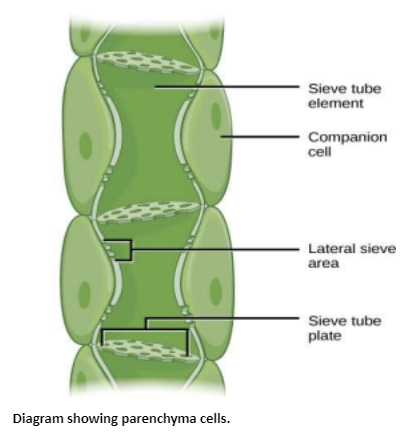
Draw the structure of parenchyma, label and mention its functions.
Answer
447.9k+ views
Hint: Parenchyma is one of the easy permanent tissues that help in creating a main portion of indispensable or ground tissues in plants. There are mainly three kinds of simple permanent tissues observed in plants Parenchyma, Collenchyma, and Sclerenchyma.
Complete answer:
Parenchyma cells are termed as living cells. A vital part for respective organisms, its basic structural characteristics are noted below.
i) This ground cell consists of distinguished protoplasts and nuclei. Mostly, parenchymas are polyhedral or isodiametric in shape. However, these cells can be observed as round, oval, elongated, or polygonal as well.
ii) The intercellular space of parenchyma is small, and the cells may additionally be tightly packed.
They have skinny cellophane walls which are composed of hemicelluloses and cellulose.
iii) In a parenchyma tissue, plasmodesmata joins all the cells. These cells have more than one small vacuole. In older parenchyma, these small vacuoles fuse and structure a large central vacuole. This large vacuole accumulates tannins or anthocyanin.

iv) Vacuoles in parenchyma have plentiful water, and they work as water reservoirs of plants.
v) Storage parenchyma can have thick mobile walls of xyloglucan like the endosperm of a date palm. During the germination of seeds, the sugar is utilised and the partitions are decreased to thin layers.
vi) Chromoplast is existing in the parenchyma of fruits and flowers.
vii) Sometimes, parenchyma also has a thick lignified mobile phone wall comparable to sclerenchyma.
viii) The mechanical power of parenchyma is derived from the cell's hydraulic property. Parenchyma contains chloroplast that in particular performs photosynthesis
Note: Parenchyma cells made up of thin-walled, living, simple, and structure-wise unspecialised cells. Thus, these cells are adaptable for quite a few functions. Notably, these floor tissues are neither embedded nor vascular. Moreover, parenchyma tissue is alive, and hence it can be worried in secretion, food storage, photosynthesis, and more than a few different existence procedures of plants.
Complete answer:
Parenchyma cells are termed as living cells. A vital part for respective organisms, its basic structural characteristics are noted below.
i) This ground cell consists of distinguished protoplasts and nuclei. Mostly, parenchymas are polyhedral or isodiametric in shape. However, these cells can be observed as round, oval, elongated, or polygonal as well.
ii) The intercellular space of parenchyma is small, and the cells may additionally be tightly packed.
They have skinny cellophane walls which are composed of hemicelluloses and cellulose.
iii) In a parenchyma tissue, plasmodesmata joins all the cells. These cells have more than one small vacuole. In older parenchyma, these small vacuoles fuse and structure a large central vacuole. This large vacuole accumulates tannins or anthocyanin.

iv) Vacuoles in parenchyma have plentiful water, and they work as water reservoirs of plants.
v) Storage parenchyma can have thick mobile walls of xyloglucan like the endosperm of a date palm. During the germination of seeds, the sugar is utilised and the partitions are decreased to thin layers.
vi) Chromoplast is existing in the parenchyma of fruits and flowers.
vii) Sometimes, parenchyma also has a thick lignified mobile phone wall comparable to sclerenchyma.
viii) The mechanical power of parenchyma is derived from the cell's hydraulic property. Parenchyma contains chloroplast that in particular performs photosynthesis
Note: Parenchyma cells made up of thin-walled, living, simple, and structure-wise unspecialised cells. Thus, these cells are adaptable for quite a few functions. Notably, these floor tissues are neither embedded nor vascular. Moreover, parenchyma tissue is alive, and hence it can be worried in secretion, food storage, photosynthesis, and more than a few different existence procedures of plants.
Recently Updated Pages
Master Class 11 Economics: Engaging Questions & Answers for Success

Master Class 11 Business Studies: Engaging Questions & Answers for Success

Master Class 11 Accountancy: Engaging Questions & Answers for Success

Master Class 11 English: Engaging Questions & Answers for Success

Master Class 11 Computer Science: Engaging Questions & Answers for Success

Master Class 11 Maths: Engaging Questions & Answers for Success

Trending doubts
Which one is a true fish A Jellyfish B Starfish C Dogfish class 11 biology CBSE

State and prove Bernoullis theorem class 11 physics CBSE

1 ton equals to A 100 kg B 1000 kg C 10 kg D 10000 class 11 physics CBSE

In which part of the body the blood is purified oxygenation class 11 biology CBSE

One Metric ton is equal to kg A 10000 B 1000 C 100 class 11 physics CBSE

Difference Between Prokaryotic Cells and Eukaryotic Cells




